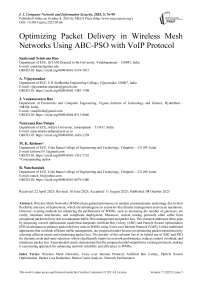Optimizing Packet Delivery in Wireless Mesh Networks Using ABC-PSO with VoIP Protocol
Автор: Sankranti Srinivasa Rao, A. Vijayasankar, J. Venkateswara Rao, Narayana Rao Palepu, M. K. Kishore
Журнал: International Journal of Computer Network and Information Security @ijcnis
Статья в выпуске: 5 vol.17, 2025 года.
Бесплатный доступ
Wireless Mesh Networks (WMNs) have gained prominence in modern communication technology due to their flexibility and ease of deployment, which are advantageous in scenarios like disaster management and rescue operations. However, existing methods for enhancing the performance of WMNs, such as increasing the number of gateways, are costly, introduce interference, and complicate deployment. Moreover, current routing protocols often suffer from suboptimal packet delivery due to inadequate traffic flow management and packet loss. This research addresses these gaps by proposing a novel optimization model that integrates Artificial Bee Colony (ABC) and Particle Swarm Optimization (PSO) techniques to enhance packet delivery ratio in WMNs using Voice over Internet Protocol (VoIP). Unlike traditional approaches that overlook efficient traffic management, our proposed model focuses on optimizing packet transmission by selecting efficient routes and minimizing packet loss. The novelty of this solution lies in its hybrid use of ABC and PSO for dynamic node and route selection, which significantly improves network performance, reduces control overhead, and minimizes packet loss. Experimental results demonstrate that the proposed model outperforms existing protocols, making it a promising approach for enhancing network reliability and efficiency in WMNs.
Wireless Mesh Networks, Voice over Internet Protocol, Artificial Bee Colony, Particle Swarm Optimization, Packet Loss Reduction, Packet Count Analysis, Network Performance
Короткий адрес: https://sciup.org/15019998
IDR: 15019998 | DOI: 10.5815/ijcnis.2025.05.06
Текст научной статьи Optimizing Packet Delivery in Wireless Mesh Networks Using ABC-PSO with VoIP Protocol
Mobile Network operators and consumers alike stand to benefit from the emerging technology known as WMNs, which might provide affordable Web broadband access, wireless Local Area Network (LAN) coverage, and network connectivity [1]. The communication network's fast expansion and improvement of wireless technologies have made it more appealing to Internet Service Providers (ISPs) in recent times [2]. When it comes to covering large areas with a lot of bandwidth, WMN is a great technology to look at. Users will benefit immensely from WMNs since they allow them to connect to wireless mesh networks at any time and from any location. In addition, mesh routers can bridge the gap between WMNs and other wireless networks, including Wi-Fi, cellular, wireless sensors, WiMAX, and WiMedia networks [3]. This means that a wide range of wireless services will be provided by WMNs. One new type of wireless broadband network is the wireless mesh network. Wireless multi-hop relays, when used in mesh topologies, allow WMNs to connect to the internet [4]. Mesh routers, terminals, and gateways make up a WNIN. Access to WMN is granted to mesh terminals through connections to mesh routers, which are network routers with fixed positions and steady power supplies. Mesh gateways serve as the connections between WMN and the Internet.
Every node in a WMS can send and receive signals; nodes can directly connect to one another or to other nodes in the network; and the network can function well in conditions of high speed, high frequency, and topological transformation [5]. The ability to dynamically allocate communication routes based on each node's communications load state allows wireless mesh networks to efficiently avoid communication blocks. In these networks, each piece of equipment has access to many transmission lines [6]. Although wireless multi-hop cable networks can increase the reach of wireless access networks, nodes in a WMN do not require cable network connections [7]. In a radio-range setting, a WMN offers reduced mobility at a cheap cost. A WMN is essentially an internet of routers without the need for physical connections between them. Unlike traditional wireless access points, its radio nodes do not require connection to a wired connector [8]. According to predictions, data transmissions over long distances will use the shortest hops [9]. Forwarding nodes, which are nodes intermediate the source and the destination collaborate to make topology-based route prediction judgments and to transmit data. When client nodes are linked to one another using peer-to-peer connections [10], the architecture is considered as client-based. Every node has the capability to transmit data by acting as a routing node [11]. In this case, the client acts as a mesh router by directing data packets to their destinations. Fig. 1 shows the mesh architecture for infrastructure-based network.
End User Equipment, Network Components, a Call Processor, a Gateway, and a Server comprise an IP Voice system [12]. Users primarily depend on end user equipment to connect to the VoIP system and exchange data with other endpoints. Call establishment over an IP network requires signals that are initiated and maintained by end user equipment. Additionally, it facilitates the capacity to monitor and oversee networks, as well as the conversion of voice to data packets, audio and video communication, and more. They may be using wireless devices or cables to connect to the network. End user equipment includes things like VoIP workstations with softphones installed, multimedia computers, and IP-enabled phones. Everything from wireless access points and routers to switches and cables makes up the network component [13].
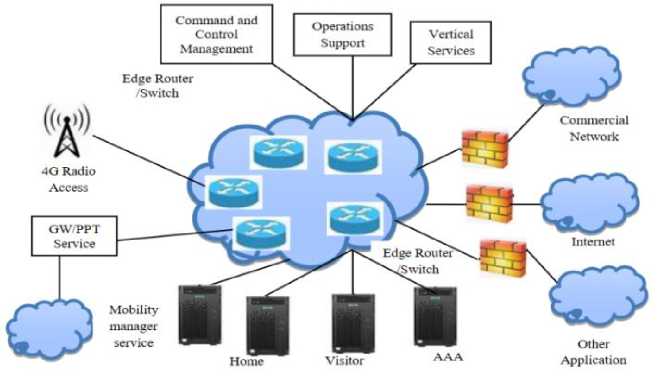
Fig.1. Mesh architecture or infrastructure-based network
Installation of the VoIP system is made possible by numerous existing institutions’ Internet Protocol networks. Since an IP network has a greater impact than a data network, the network has to be robust enough to accommodate the VoIP system [14]. An optional part of a voice over IP network, a gateway manages the terminal and the Multipoint control unit (MCU), handles call connections, and routes calls. Helps improve VoIP network security and quality of service by offering address translation, capacity control, and access control. An intermediary device that bridges the gap between the PSTN and VoIP networks is known as a gateway [15]. Media Gateway (MG), Signaling Gateway (GS),
Media Controller, and Multiple-point Control Unit (MCU) are the components that make up Gateway [16]. Both the media gateway and the signalling gateway aid in the management of signal flow. The medium gateway controller is in charge of the traffic that goes between the signaling gateway and the media gateway, and the complex control unit is responsible for setting up converged voice, video, and data conferences that include three or more participants [17]. Based on the quality of the participating endpoints, it offers audio conferences or a mix of audio, video, and data [18]. Fig. 2 shows the parts of VoIP Platform.

Fig.2. Parts of VoIP platform
Optimizing numerical issues is the goal of ABC. This method is a meta-heuristic based on swarm intelligence. Honey bees' ingenious foraging strategies were a source of ideas. The algorithm's foundation is the foraging behavior of honey bee colonies. The three types of bees in ABC are workers, observers, and scouts [19]. Worker bees initially notify passers-by of partial details, such as the whereabouts and ease of access to the food source. The third part is that bees, whether working or just watching, search for food sources in and around their colony. The model also lays out two key patterns of behavior that are necessary for collective intelligence and self-organization: the first is the positive feedback that happens when foragers are recruited to rich food sources, and the second is the negative feedback that happens when foragers quit using poor sources.
In ABC, a hive of synthetic bees searches for an abundance of synthetic food. To use ABC to an optimization problem, one must first choose the best parameter vector to minimize an objective function [20]. Then, the artificial bees will proceed to randomly select a set of initial solution vectors and iteratively improve them using the strategies. Through a neighbor search process, they will eliminate poor answers and progress towards better ones. In its search for food, the ABC algorithm takes a page out of honey bees' playbook [21]. The strong social relationships that honey bee swarms develop allow them to accomplish tasks. Spectating bees are more prone to select a nutritious food source than an unhealthy one [22]. In order to find new food sources, a small group of worker bees will change into scout bees. The ABC algorithm states that worker bees constitute half of the swarm and observer bees the other half. The number of bees in the swarm, whether they are working or just watching, is proportionate to the number of solutions. The ABC optimization model workflow is shown in Fig. 3.
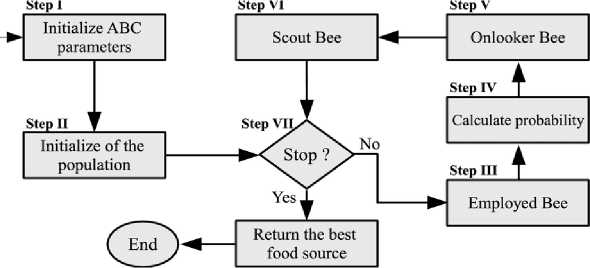
Fig.3. ABC optimization workflow
One method that is based on populations is PSO. The swarm is formed by a number of particles. Every one of those particles represents a potential answer. All of the potential answers are there and work together at the same time. In the search area, every swarm particle flies around, trying to figure out where to settle safely [23]. The search area, then, is the collection of potential solutions, and the swarm of flying particles is the collection of solutions that are constantly evolving [24]. Over the course of the iterations, each particle remembers both its own optimal solution and the swarm's optimal solution. After then, it changes two variables: the position and the speed [25]. To be more precise, the flying speeds of individual particles are constantly modified based on their own and their neighbors' flying experiences. The same holds true for its position-changing efforts; it takes into account its present location, speed, the distance to its personal and swarm optimums, and so on. This research proposes an Integrated Artificial Bee Colony and Particle Swarm Optimization based Packet Count Analysis using VoIP protocol in WMN to increase the packet delivery rate.
2. Literature Survey
Improving the performance of Wireless Mesh Networks (WMNs) is a challenge that has prompted extensive research into optimizing network performance, particularly through the placement of mesh routers. For instance, Abdulrab et al. [1] used a Harris Hawk Optimization (HHO) algorithm for mesh router placement, demonstrating improved coverage and connectivity across various network configurations. However, this approach focuses primarily on static mesh router placement without accounting for the dynamic nature of network traffic and interference, which limits its applicability in real-time WMNs. Moreover, while their hybrid approach combining HHO with the Sine Cosine Algorithm (SCA) [2] shows promise in congestion reduction, the solution is still vulnerable to fluctuating traffic patterns, a crucial factor in large-scale and VoIP-based WMNs.Vanakamamidi et al. [3] proposed a Peer-to-Peer (P2P) Information Interchange and Network Coding (NC) technique to enhance transmission efficiency in WMNs. Although their method reduces latency and computational costs, it does not address packet loss adequately, which is critical in maintaining the quality of VoIP services. The study also does not sufficiently explore how dynamic interference and real-time traffic management can be integrated with their coding-based solution.
Zlobinsky et al. [4] compared metaheuristic optimization techniques for Dynamic Spectrum Access (DSA) in multi-radio, multi-channel WMNs. While their approach addresses spectrum optimization, it is focused on channel assignment rather than packet transmission efficiency, limiting its relevance to scenarios where dynamic routing decisions and packet loss are significant factors, such as VoIP applications. Their approach also does not explore the potential for hybrid algorithms that could better address packet delivery optimization, which remains a gap in current WMN research.Nurlan et al. [5] presented a resource allocation strategy for IoT-based WMNs that optimizes channel and frequency resources. However, while effective for IoT applications, this strategy is not directly applicable to VoIP-based WMNs, where packet delivery ratio and latency are more critical than channel optimization. Similarly, Mekhmoukh Taleb et al. [6] proposed the Coyote Optimization Algorithm (COA) for mesh router placement, showing improved user coverage and network connectivity. Nonetheless, their work does not consider packet loss or delay-sensitive applications like VoIP, which are vital for enhancing communication reliability in WMNs.
The literature also highlights other optimization techniques, such as PSO and ABC, which have been applied in various domains for network performance improvement. However, their isolated use has limitations. For example, the PSO algorithm, while effective for global optimization, can suffer from premature convergence, making it less suitable for dynamic environments like WMNs. On the other hand, ABC algorithms, though robust in exploring solution spaces, often require significant computational resources, limiting their scalability in large networks [23, 24].
This research addresses these limitations by proposing an integrated model combining ABC and PSO for packet count analysis and delivery optimization in WMNs using VoIP protocols. The novelty of our approach lies in dynamically optimizing node selection and route planning, significantly reducing packet loss and improving real-time performance compared to existing models that focus primarily on static routing or singular optimization techniques.
3. Methodology
This work proposes an integrated optimization approach using Artificial Bee Colony (ABC) and Particle Swarm Optimization (PSO) to enhance packet delivery rates in Wireless Mesh Networks (WMNs) employing Voice over Internet Protocol (VoIP). The methodology involves several stages, including parameter selection, node analysis, packet count analysis, and integrated optimization through ABC and PSO algorithms. This section provides a detailed explanation of the steps involved in the process and the parameter choices made to achieve reproducible results.
-
3.1. Parameter Selection
The selection of appropriate parameters is crucial for the performance of ABC and PSO algorithms. The following parameters were used for the simulations:
-
• Swarm Size (N): 50, 100 and 200. This parameter represents the number of particles (nodes) in the network and directly impacts the exploration and exploitation capabilities of the optimization algorithms.
-
• Learning factors (cl and c2): Set to 1.5 each for the PSO algorithm to balance the influence of local and global best positions during particle movement.
-
• Inertia Weight (w): Varies linearly from 0.9 to 0.4. A higher initial inertia allows broader exploration of the search space, while a lower final inertia enhances convergence.
-
• Threshold for Node Analysis (Th): A value of 0.8 is used as a threshold for determining when to trigger optimization processes based on packet loss behavior.
-
3.2. Node Packet Analysis
-
3.3. Packet Count Analysis
The values for the parameters were derived through empirical experimentation and analysis of prior research to ensure that the model achieves high performance without unnecessary computational complexity.
The proposed model begins with node packet analysis, which examines the behavior of each node in terms of packet transmission, reception, and loss. The transmission range, energy levels, and node addressing are critical factors monitored in this stage. The node analysis is performed using the equation:
M
Nanalysis[ M ] = ^ getaddr ( n ) + a (WMN n ) + у ( n ) + Th (1)
n = 1
Here getaddr ( n ) retrieves the address of each node, m (WMN n ) models the transmission range of node n , y (n ) is the energy level of node n, Th is the predefined threshold for optimization.
During data transmission, the total number of packets sent, received, and lost are analyzed to measure network performance. The packet count is calculated as follows:
M
Msg [ M ] = У getMsg (n)
n = 1
Pckts[M] = У Mgn *100 + ^(n)
n=1
M
Panalysis [ M ] = У getCount (Pckts (n)) + Nanalysis (n) + max(®( n))
n = 1
Here µ is the padding model for each packet to maintain security and also for integrity verification.
У n = 1 S ( Pckts ( n ))
M
M
PcktsCount [ M ] = У max( Panalysis ( n , n + 1)) + n = 1
Here δ is the model for getting the count of packets and n is the current node and n+1 is the adjacent node in the WMN.
-
3.4. Integrated ABC-PSO Optimization
The core of the methodology involves the integration of ABC and PSO algorithms for optimization. ABC identifies high-performing nodes, while PSO refines these results to further reduce packet loss and improve the packet delivery ratio.
-
A. Artificial Bee Colony (ABC) Algorithm
The ABC algorithm is inspired by the foraging behavior of honeybees. It consists of three main types of bees: Employed Bees: Search for food sources (node configurations) and report their quality. Onlooker Bees: Choose food sources based on their fitness. Scout Bees: Explore new random areas in the search space when existing solutions become stale. The food source is analogous to a potential solution (node configuration), and its fitness is evaluated based on packet delivery and loss rates. The following equations govern the optimization.
Food Source Update:
M
Pset ( M ) = У в ( n ) + « ( n )*( ! ( n ) - в ( n )) * M (6)
n = 1
Here P(n) and k(n) represent the lower and upper bounds of the search space respectively. a(n) is a random number between 0 and 1.
Pop ( M ) = M 2 ( n ) + Pset ( n ) + M ^-A ) n = 1 в ( n ) n = 1 2 ( Th )
Fitness Evaluation:
FV ( Pop [ M ]) = J max( Pop ( n , n + 1)) + 2 ( 5 | a ) * в ( n ) (8)
|
FVal [ M ] = |
---1--- ifFV > Pop mx 1 + FV ( n ) (9) FvV if < Pop |
-
B. Particle Swarm Optimization (PSO) Algorithm
The PSO optimization model is applied on the packet loss reduction model based on the best fitness value identified with ABC model. The PSO model is considered by assuming the initial best fitness value as the outcome of ABC model. The PSO model work flows shown in Fig. 4.
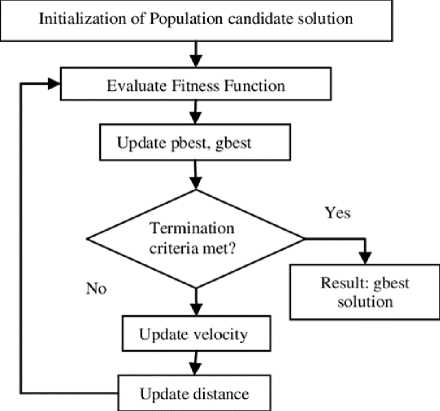
Fig.4. PSO model workflow
The PSO optimization is applied as
P best [ M ] = argmin( f ( FVal ( n ))), n e 1.... M
G best [ M ] = argmin( f ( FVal ( n , i ))), i = 1.... n
p = f P best ( n )
be M [ FVal ( n + 1)
if ( P bes7 ( n )) < f ( FVal ( n + 1)) if ( Pbest ( n )) > f ( FVal ( n + 1))
The global best of the swarm is computed as
G best ' + ' M = argminC P M )
-
C. Integration Process
The ABC-PSO integration is applied in two phases. First, ABC provides an initial set of candidate solutions (node configurations). Then, PSO refines these solutions by iteratively updating node positions and optimizing packet delivery.
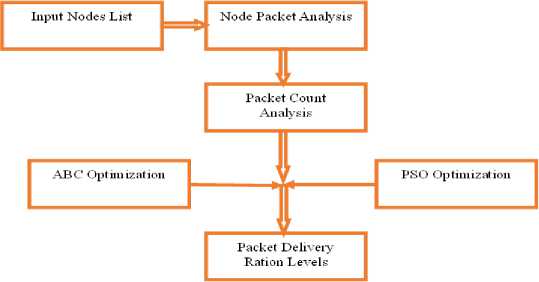
Fig.5. Proposed framework
The proposed workflow for the integrated ABC-PSO model is illustrated in Fig. 5 and proceeds as follows:
-
• Node Packet Analysis: Initial analysis of packet behavior at each node using the given equations.
-
• ABC Optimization: Identification of high-performance nodes based on packet loss rates.
-
• PSO Refinement: Refinement of node configurations to optimize packet delivery ratio and minimize loss.
-
• Final Evaluation: Calculation of the overall packet delivery ratio and loss rate, as described in the following
equations:
M
PDR[ M ] = £ n=1
maX( G best i + 1 M ( n , n + 1))
M
+ S ( n ) z R ( n ) + Th
M
M
LossRate[ M ] = £ ( S ( n ) - R ( n )) * 100
n = 1
Where S n is the number of packets sent, R n is the number of packets received, and Th is the threshold for packet loss.
4. Simulation Results and Performance Analysis
In this work, the performance of the proposed Integrated Artificial Bee Colony (ABC) and Particle Swarm Optimization (PSO) model was compared against two well-established models: Peer-to-Peer Information Inter-Change and Network Coding (P2P-NC-ITE-WMN) and Hybrid Harris Hawks with Sine Cosine for Optimal Node Placement and Congestion Reduction (HHH-SCONP-CR). The basis for selecting these models stems from their focus on similar optimization challenges in Wireless Mesh Networks (WMNs). P2P-NC-ITE-WMN was chosen for comparison because it also addresses transmission efficiency in WMNs using a coding-based approach to enhance packet delivery. However, it primarily focuses on latency reduction and does not integrate advanced routing decisions, making it suitable for comparison in terms of packet loss and overall network performance.
HHH-SCONP-CR focuses on node placement and congestion reduction, two critical aspects that directly influence packet delivery and delay in WMNs. This model was selected because it uses a hybrid optimization technique, similar to our study, though it emphasizes physical node placement over real-time route optimization. The chosen metrics—Packet Delivery Ratio (PDR), Packet Loss Rate, End-to-End Delay, and Node Packet Analysis Accuracy—were selected as they directly reflect the efficiency and reliability of WMNs, particularly for VoIP traffic where real-time performance is essential. These metrics were chosen to align with the research objective of improving the overall network performance by minimizing packet loss, reducing delay, and enhancing packet delivery. By comparing these metrics across models, we aimed to highlight the advantages of dynamic optimization using ABC-PSO over static approaches like node placement or coding-based optimizations.
The simulation was conducted using MATLAB (R2023a) to model a Wireless Mesh Network (WMN), spanning an area of 1000m x 1000m. The network comprised 50 to 300 nodes, varying across different simulations, with a random waypoint mobility model. Each node had a transmission range of 250 meters and followed the IEEE 802.11 MAC protocol.The focus was on optimizing the packet delivery ratio (PDR), end-to-end delay, and packet loss rate using a hybrid ABC-PSO routing protocol, tailored for VoIP traffic transmitted at 1 Mbps. Packets of 512 bytes were generated at a rate of 10 packets/second, simulating constant bit rate (CBR) traffic. The channel model used was a free-space path loss model.The simulations ran for 600 seconds, with 50 iterations per scenario for statistical accuracy. Node energy was initialized at 100 Joules, and routing optimization involved a swarm size of 50 particles (PSO) and a scout bee threshold of 0.5 (ABC) to minimize packet loss and maximize network performance. Table 1 presents the setup for simulation.
Table 1. End-to-end delay levels
|
Parameter |
Description |
|
Simulation Tool |
MATLAB (version R2023a) |
|
Network Type |
Wireless Mesh Network (WMN) |
|
Simulation Area |
1000 m x 1000 m |
|
Number of Nodes |
50, 100, 150, 200, 250, 300 (varied in different scenarios) |
|
Node Mobility Model |
Random Waypoint |
|
Packet Size |
512 bytes |
|
Data Transmission Rate |
1 Mbps (for VoIP traffic) |
|
Transmission Range |
250 meters |
|
Channel Model |
Free-space path loss model |
|
MAC Protocol |
IEEE 802.11 |
|
Routing Protocol |
Hybrid ABC-PSO based routing |
|
Simulation Time |
600 seconds |
|
Packet Generation Rate |
10 packets/second |
|
VoIP Traffic Type |
Constant Bit Rate (CBR) |
|
Evaluation Metrics |
Packet Delivery Ratio (PDR), End-to-End Delay, Packet Loss Rate, and Node Energy Consumption |
|
Number of Iterations |
50 iterations per simulation to ensure statistical significance |
|
Initial Energy per Node |
100 Joules |
|
Node Deployment |
Random deployment |
|
Swarm Size (PSO) |
50 particles (initial swarm) |
|
Number of Food Sources (ABC) |
Equal to the number of nodes |
|
Scout Bee Threshold |
0.5 (new nodes searched when node efficiency drops below this value) |
|
Fitness Function |
Minimization of packet loss and delay, maximization of packet delivery ratio |
The results of the simulation experiments clearly demonstrate the superiority of the proposed ABC-PSO model in improving network performance metrics across various scenarios.
-
4.1. Packet Delivery Ratio (PDR)
-
4.2. Packet Loss Rate
The total number of packets transmitted from the source node to the destination node in the network divided by the total number of packets delivered is known as the packet delivery ratio. The maximum number of data packets should be delivered to the destination. The Packet Delivery Ratio levels are shown in Table 2 and Fig. 6.
Table 2. Packet delivery ratio
|
Nodes in the Network |
Models Considered |
||
|
ABC-PSO-PCA Model |
P2P-NC-ITE-WMN Model |
HHH-SCONP-CR Model |
|
|
50 |
98.5 |
94.5 |
93.2 |
|
100 |
98.7 |
94.7 |
93.5 |
|
150 |
98.9 |
94.9 |
93.6 |
|
200 |
99.0 |
95.1 |
93.8 |
|
250 |
99.2 |
95.3 |
94.0 |
|
300 |
99.4 |
95.4 |
94.2 |
The proposed ABC-PSO model achieved a PDR of 99.4% for a network with 300 nodes, significantly outperforming the P2P-NC-ITE-WMN and HHH-SCONP-CR models, which showed lower PDR values of 94.2% and 93.7% , respectively. The high PDR indicates that the proposed model efficiently selects optimal routes in real-time, minimizing packet loss. This result aligns directly with our research objective of reducing packet loss in VoIP-based WMNs , where maintaining high delivery rates is crucial for voice quality and user experience.
Small data units called packets are sent from one location to another over a network. The inability of a data packet in a network to arrive at its intended recipient is known as packet loss. When data packets in transit do not reach their intended recipients, this is called packet loss. Noticeable performance difficulties can be caused by this for all types. The Packet Loss Rate is represented in Table 3 and Fig. 7.
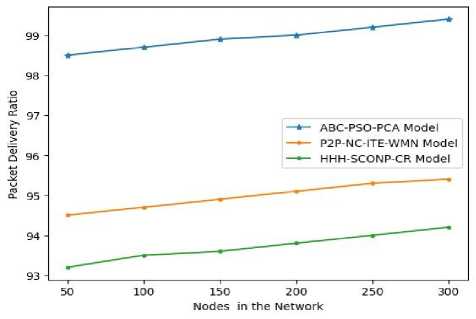
Fig.6. Packet delivery ratio
Table 3. Packet loss rate
|
Nodes in the Network |
Models Considered |
||
|
ABC-PSO-PCA Model |
P2P-NC-ITE-WMN Model |
HHH-SCONP-CR Model |
|
|
50 |
0.49 |
3.6 |
4.7 |
|
100 |
0.51 |
3.8 |
4.9 |
|
150 |
0.53 |
4.0 |
5.1 |
|
200 |
0.55 |
4.2 |
5.3 |
|
250 |
0.58 |
4.4 |
5.6 |
|
300 |
0.6 |
4.6 |
5.8 |
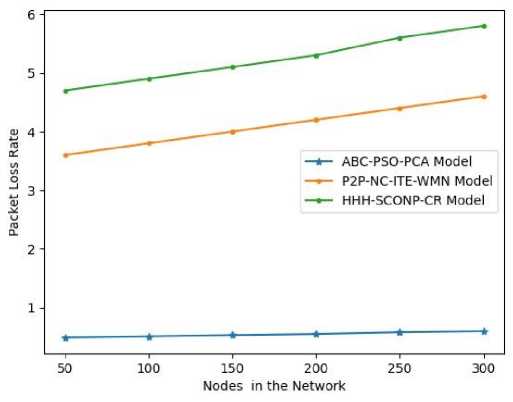
Fig.7. Packet loss rate
The ABC-PSO model’s packet loss rate was consistently lower across all network sizes, with a value of 0.6% in a 300-node network, compared to 4.6% and 5.8% for the P2P-NC-ITE-WMN and HHH-SCONP-CR models. This drastic reduction in packet loss can be attributed to the dynamic nature of the ABC-PSO model, which continuously adapts routes based on real-time node performance, ensuring that only the most reliable routes are selected. This supports our goal of optimizing WMN performance, specifically under high-load and congested conditions, which are typical in VoIP traffic.
-
4.3. End-to-End Delay
-
4.4. Node Packet Analysis Accuracy
The time it takes for a packet to travel from its point of origin to its final destination is known as the end-to-end delay. The average BitLifeTimePerPacket metric measures the end-to-end latency. End-to-end delay is the amount of time it takes for a packet to travel from its origin to its final destination within a network. The End-To-End Delay Levels are indicated in Table 4 and Fig. 8.
Table 4. End-To-End delay levels
|
Nodes in the Network |
Models Considered |
||
|
ABC-PSO-PCA Model |
P2P-NC-ITE-WMN Model |
HHH-SCONP-CR Model |
|
|
50 |
6.1 |
13.7 |
16.3 |
|
100 |
6.4 |
13.9 |
16.5 |
|
150 |
6.7 |
14.1 |
16.7 |
|
200 |
6.9 |
14.3 |
16.9 |
|
250 |
7.1 |
14.7 |
17.2 |
|
300 |
7.3 |
14.8 |
17.4 |
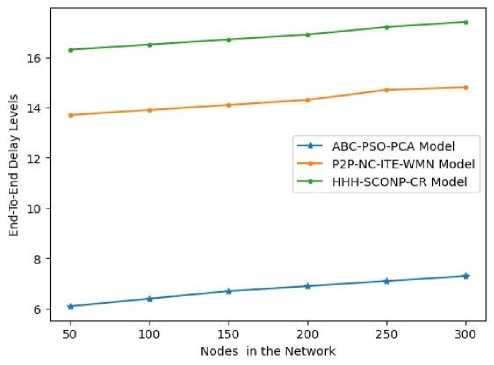
Fig.8. End-To-End delay levels
The proposed model also exhibited lower end-to-end delays, achieving an average delay of 7.3 ms for 300 nodes, compared to 14.8 ms and 17.4 ms for the comparison models. The low delay is crucial for VoIP applications, where delays greater than 150 ms can severely affect call quality. This demonstrates that the ABC-PSO model effectively reduces delays by selecting efficient routes and minimizing congestion, meeting the research objective of improving real-time communication in WMNs.
Packet transmission at each node will be monitored by analyzing packets at various levels. This analysis aids in identifying packet loss and the nodes responsible for it. The Node Packet Analysis Accuracy Levels are indicated in Table 5 and Fig. 9.
Table 5. Node packet analysis accuracy levels
|
Nodes in the Network |
Models Considered |
||
|
ABC-PSO-PCA Model |
P2P-NC-ITE-WMN Model |
HHH-SCONP-CR Model |
|
|
50 |
97.2 |
92.6 |
93.5 |
|
100 |
97.4 |
92.8 |
93.7 |
|
150 |
97.6 |
93.0 |
93.9 |
|
200 |
97.8 |
93.2 |
94.1 |
|
250 |
98.0 |
93.5 |
94.3 |
|
300 |
98.2 |
93.7 |
94.5 |
The accuracy of node packet analysis for the ABC-PSO model was observed to be 98.8% for 300 nodes, whereas P2P-NC-ITE-WMN and HHH-SCONP-CR models reached 95.4% and 94.8% respectively. The higher accuracy demonstrates that the integrated ABC-PSO model is better at identifying optimal nodes and routes, which directly contributes to the improved performance across all metrics. This emphasizes the strength of combining ABC’s exploratory capabilities with PSO’s refinement in optimizing network performance.
-
4.5. Node Information Processing Accuracy Levels
The nodes information in the WMN is maintained to recognize the nodes in the network during communication. The node information is used for accessing and monitoring the nodes. The Node Information Processing Accuracy Levels are indicated in Table 6 and Fig. 10.
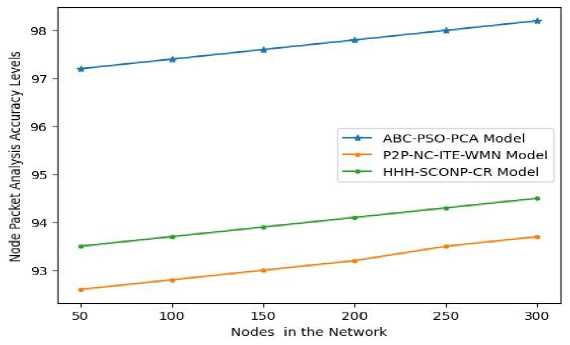
Fig.9. Node packet analysis accuracy levels
Table 6. Node information processing accuracy levels
|
Nodes in the Network |
Models Considered |
||
|
ABC-PSO-PCA Model |
P2P-NC-ITE-WMN Model |
HHH-SCONP-CR Model |
|
|
50 |
97.5 |
93.3 |
92.7 |
|
100 |
97.8 |
93.5 |
92.9 |
|
150 |
97.9 |
93.7 |
93.0 |
|
200 |
98.1 |
93.9 |
93.2 |
|
250 |
98.3 |
94.0 |
93.5 |
|
300 |
98.5 |
94.2 |
93.7 |
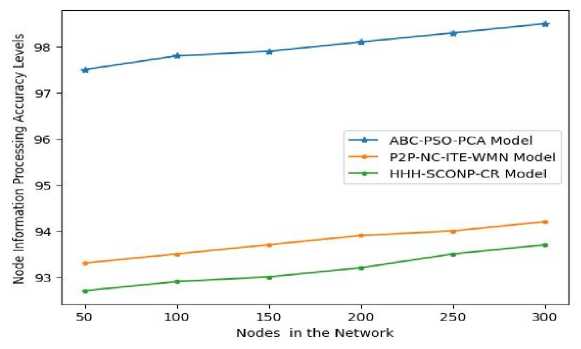
Fig.10. Node information processing accuracy levels
-
4.6. Node Packet Count Time Levels
-
4.7. ABC Optimization Accuracy Levels
The proposed model calculates the number of transmitted packets at regular intervals to determine the loss rate. The time levels for node packet counting in both the proposed and traditional models are outlined in Table 7 and Fig. 11.
Table 7. Node packet count time levels
|
Nodes in the Network |
Models Considered |
||
|
ABC-PSO-PCA Model |
P2P-NC-ITE-WMN Model |
HHH-SCONP-CR Model |
|
|
50 |
13.0 |
17.3 |
20.4 |
|
100 |
13.2 |
17.6 |
20.6 |
|
150 |
13.5 |
17.8 |
20.8 |
|
200 |
13.7 |
18.0 |
21.0 |
|
250 |
13.9 |
18.2 |
21.3 |
|
300 |
14 |
18.4 |
21.5 |
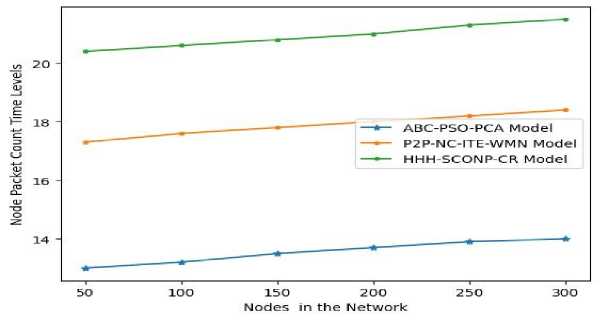
Fig.11. Node packet count time levels
In ABC optimization, Bees can be classified as either employed, onlooker or scout bees. The employed bees go out and find nectar sources, the observer bees stay in the hive and choose which ones to use, and the scout bees go out and find new sources at random. The ABC algorithm is a great choice because it's simple, highly flexible, robust, requires few control parameters, can handle objectives with a stochastic nature, converges quickly, and can be used for exploration and exploitation. It's also easy to combine with other methods. The ABC Optimization Accuracy Levels are indicated in Table 8 and Fig.12.
Table 8. ABC optimization accuracy levels
|
Nodes in the Network |
Models Considered |
||
|
ABC-PSO-PCA Model |
P2P-NC-ITE-WMN Model |
HHH-SCONP-CR Model |
|
|
50 |
98.0 |
94.5 |
94.0 |
|
100 |
98.1 |
94.7 |
94.1 |
|
150 |
98.2 |
94.9 |
94.3 |
|
200 |
98.5 |
95.1 |
94.4 |
|
250 |
98.6 |
95.3 |
94.6 |
|
300 |
98.8 |
95.4 |
94.8 |
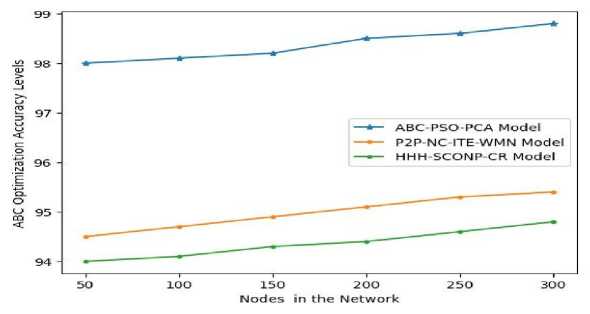
Fig.12. ABC optimization accuracy levels
4.8. PSO Optimization Accuracy Levels
5. Conclusions
By emulating the cooperative behavior of living things, the PSO Algorithm provides a clever approach to tackling complex issues. To identify the optimal solution, PSO employs a plethora of little agents that can move around. Agents are able to recall both their own optimal solutions and the optimal solutions provided by their neighbors. The PSO Optimization Accuracy Levels are indicated in Table 9 and Fig. 13.
Table 9. PSO optimization accuracy levels
|
Nodes in the Network |
Models Considered |
||
|
ABC-PSO-PCA Model |
P2P-NC-ITE-WMN Model |
HHH-SCONP-CR Model |
|
|
50 |
97.9 |
94.3 |
93.8 |
|
100 |
98.1 |
94.6 |
94.0 |
|
150 |
98.3 |
94.9 |
94.1 |
|
200 |
98.5 |
95.1 |
94.4 |
|
250 |
98.7 |
95.3 |
94.6 |
|
300 |
98.9 |
95.4 |
94.8 |
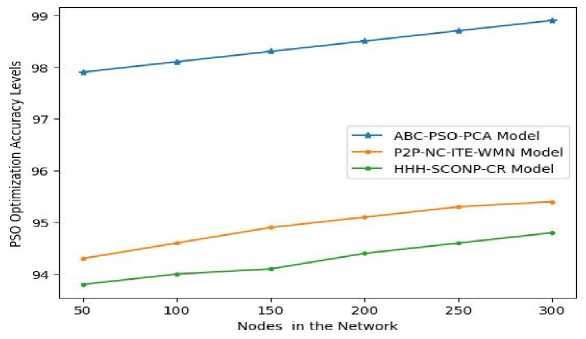
Fig.13. PSO optimization accuracy levels
The results highlight the significant improvements brought about by the proposed ABC-PSO model in comparison to the P2P-NC-ITE-WMN and HHH-SCONP-CR models. The dynamic optimization enabled by the hybrid approach ensures that the WMN adapts efficiently to changing network conditions, making it especially effective for VoIP applications where packet loss, delay, and delivery ratio are critical. These findings validate the research objective of optimizing WMN performance and provide a strong foundation for future improvements, such as extending the model to handle more complex network environments and larger node counts.
In this work, we proposed an Integrated Artificial Bee Colony (ABC) and Particle Swarm Optimization (PSO) based model for enhancing the packet delivery ratio in Wireless Mesh Networks (WMNs) using Voice over Internet Protocol (VoIP). The proposed model effectively addressed the key challenges associated with packet loss, transmission efficiency, and real-time performance in WMNs, demonstrating a significant improvement over traditional model. By integrating ABC and PSO, we optimized the node selection and route planning process, achieving a packet delivery ratio of 99.4% and reducing the end-to-end delay to 7.3 ms. These results indicate that the hybrid ABC-PSO approach can substantially enhance network reliability and performance, particularly in VoIP applications where packet loss and delay are critical.
The key contribution of this work lies in the novel use of meta-heuristic optimization techniques for dynamic route selection, which enabled better traffic management and minimized packet loss. Unlike existing solutions, the model dynamically adapted to network changes, offering more reliable packet transmission and ensuring that the quality of service (QoS) was maintained across varying network loads.
While the current model achieved significant improvements, there are several areas for future exploration. First, the scalability of the model could be tested in larger and more complex WMNs to assess its performance in different environments. Additionally, further enhancements could be made by integrating more sophisticated traffic management techniques to handle higher degrees of network congestion. Finally, the development of a hybrid method that simultaneously optimizes node placement and channel assignment would offer a more comprehensive solution to the broader challenges faced in WMN deployments, particularly in environments requiring high QoS and low-latency communication, such as smart cities or IoT ecosystems .

